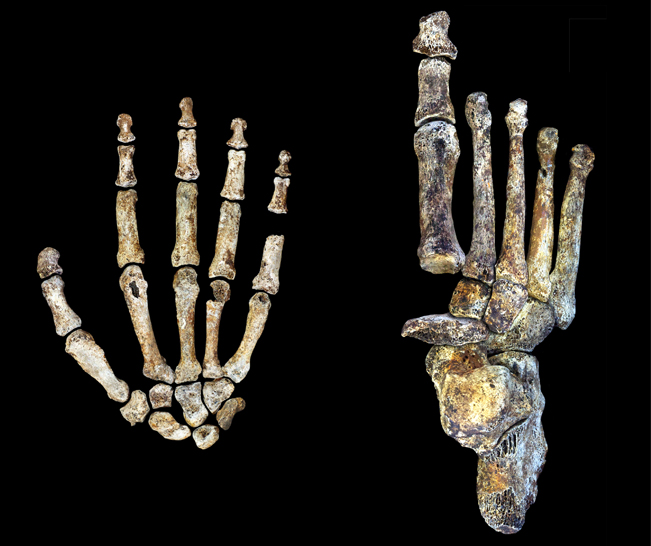Homo naledi hand and foot
Homo naledi climbed trees and walked upright:
Hand and foot
Two papers in Nature Communications reveal unique movement
 The second set of papers related to the remarkable discovery of Homo naledi, a new species of human relative, show that Homo naledi had unique Tarzan-features – climbing trees as well as walking upright.
The second set of papers related to the remarkable discovery of Homo naledi, a new species of human relative, show that Homo naledi had unique Tarzan-features – climbing trees as well as walking upright.
The two papers, titled: Nature CommsThe foot of Homo naledi.pdf and Nature CommsThe hand of Homo naledi.pdf, describe the structure and function of the H. naledi hand and foot.
Taken together, the findings indicate H. naledi may have been uniquely adapted for both tree climbing and walking as dominant forms of movement, while also being capable of precise manual manipulation.
Rising Star Expedition
The fossils were revealed for the first time during an international launch at the Maropeng Visitor’s Centre in the Cradle of Humankind World Heritage Site, attended by representatives from the South African government, participating researchers from all over the world, as well as local and international media.
It has been much anticipated since Professor Lee Berger from the Evolutionary Studies Institute at Wits and a team of international researchers, cavers and explorers announced in November 2013 that they had discovered a significant fossil find in a cave known as Rising Star in the Cradle of Humankind, some 50 kilometers northwest of Johannesburg.
The foot of Homo naledi
Lead author William Harcourt-Smith and colleagues describe the H. naledi foot based on 107 foot elements from the Denaldi Chamber, including a well preserved adult right foot. They show the H. naledi foot shares many features with a modern human foot, indicating it is well-adapted for standing and walking on two feet. However, the authors note it differs in having more curved toe bones (proximal phalanges).
The hand of Homo naledi
Lead author Tracey Kivell and colleagues describe the H. naledi hand based on nearly 150 hand bones from the Denaldi Chamber, including a nearly complete adult right hand (missing only one wrist bone) of a single individual, which is a rare find in the human fossil record.
The H. naledi hand reveals a unique combination of anatomy that has not been found in any other fossil human before. The wrist bones and thumb show anatomical features that are shared with Neandertals and humans and suggest powerful grasping and the ability to use stone tools
However, the finger bones are more curved than most early fossil human species, such as Lucy’s species Australopithecus afarensis, suggesting that H. naledi still used their hands for climbing in the trees. This mix of human-like features in combination with more primitive features demonstrates that the H. naledi hand was both specialised for complex tool-use activities, but still used for climbing locomotion.
The tool-using features of the H. naledi hand in combination with its small brain size has interesting implications for what cognitive requirements might be needed to make and use tools, and, depending on the age of these fossils, who might have made the stone tools that we find in South Africa,” says Kivell.
International publication
The papers have been published in scientific journal, Nature Communications, on Tuesday, 6 October 2015.

